Care
The most important point that should be taken very carefully is watering. For any peonies, including Karl Rosenfeld, the amount of moisture is the main factor in shaping the appearance. With insufficient watering, the flowers will be small and unsightly.
For the quality development of the plant, it is necessary to ensure constant air penetration to the roots. To do this, you should regularly weed the soil around the peonies, and at the same time loosen it.
The peonies Karl Rosenfeld have powerful stems, so under normal conditions they do not need any support. But prolonged rains can cause the bushes to fall. This problem is best prevented by installing supports and tying plants to them.
In order for the bush to be lush and bloom well, it must be pruned periodically. A radical haircut is done at the end of October, all stems are shortened to a height of 20 cm from the ground surface. During the rest of the time, only those parts of the peony that fade are cut off.
Also, the bush is formed by removing flowers. In the first year, you need to pinch the buds that have just appeared, in the second, pick all the flowers on the sides, leaving only the one that grows in the center. Thanks to such procedures, the peony in subsequent years will delight with splendor and abundant flowering.
It doesn't take long to get ready for winter. Peony Karl Rosenfeld perfectly withstands frosts up to 40 degrees. It only needs to be hilled before the onset of winter and covered with compost, peat or rotted manure around the soil.
Peony Blossom Karl Rosenfield
Peony Coral Charm (Paeonia Coral Charm) - features of breeding varieties
Subject to a number of conditions and proper care, the Karl Rosenfield peony begins to bloom in 2-3 years. The flowering period is 2-3 weeks. Description of the blooming bud:
- flowers are simple and semi-double, single;
- diameter of dense inflorescences about 18 cm;
- the color scheme is varied, you can find a bright red bud with a purple tint, white and pink; often come across bright pink with a red tint;
- the edges of the large petals are curved, wavy.
Note! During the first flowering period, 1 bud remains, the rest must be cut off. This will help to strengthen the next shoots, and the subsequent flowering will become more lush.
A period of activity and rest
Activity starts around early or mid-April
Lactiflora Karl Rosenfield draws attention before freezing. There is a dormant period from November to March
Care during and after flowering
Features of the use of fertilizers:
| Month | Period | Fertilizers | |
| 1 | April | First shoots | Nitrogen-containing 70 g per bush |
| 2 | May June | Buds appear | Bucket of poultry manure or mullein solution |
| 3 | July August | End of flowering | Phosphorus-potassium |
| 4 | September | Add 50 g of superphosphate to 10-15 kg of humus | |
| 5 | October | Preparing for rest | It's good to dig the earth. Mix 30 g of phosphate-potassium fertilizer with 15 kg of compost or rotted manure |
Preparing for a dormant period in the fall
What to do if it does not bloom, possible reasons
The culture may not bloom in due time for the following reasons:
- little light;
- a lot of moisture;
- the plant has been exposed to diseases and attacks of pests;
- thin soil or insufficient nutrients.
To rectify the situation, you should find out the reason. If the diagnosis and elimination did not help, the peonies are transplanted.
On a note! After re-transplanting, the plant will bloom in 2-3 years.
Features of reproduction and transplantation
Propagated by seed and vegetative method. The best way is to divide the bush. Reception allows you to divide it into parts if the age reaches 8-10 years. It is better to carry out division at the end of August or in September.
The overgrown culture must be carefully dug out of the ground, carefully remove the soil from the rhizomes. Further, it is imperative to rinse the roots with water and divide into shares so that on each new rhizome there are 3-5 buds about 7 centimeters long and 3 adventitious roots
The resulting cuttings for disinfection are treated with a solution of potassium permanganate.
Planting can be done only after a few days, since the slices need to dry out in order to prevent further decay. It is impossible to place them on the old flower bed; for transplanting, you must definitely choose a new bed. Seed propagation is considered less effective due to the long wait for the buds to appear. A peony will bloom with this form of planting no earlier than 5 years later. Basically, it is only used by breeders. When transplanted by division, flowers appear in the second or third year.
Plant care
Peonies will not take root without timely feeding, watering and other processing.
Watering and feeding
Peony Buckeye Bell (Paeonia Buckeye Belle) - features of cultivation
For each bush, a bucket of well or settled water is consumed. During drought, the frequency of watering is 1-2 times every 7 days, in normal weather - once every 1.5-2 weeks. The main thing is not to allow the soil to completely dry out.
Top dressing is carried out immediately after planting, then in the season before flowering.
Mulching and loosening
This will help retain moisture and feed the bush. Mulching begins in spring. Best after loosening. Used as mulch:
- sawdust;
- peat;
- humus;
- fallen leaves.
Additional Information! To avoid fungal infections, the mulch is laid in a layer of 0.5-1 cm.Using loosening, it will be possible to remove unnecessary weeds, fill the root system with oxygen.
Preventive treatment
Carried out before landing. Saplings are processed with potassium permanganate, the cuts are covered with coal or covered with brilliant green. It is advisable to treat the root zone with Bordeaux liquid. During growth and development, it is worth spraying the bushes with solutions from pests and diseases.

Soaking the seedling before planting it in the ground
Description of peony Karl Rosenfield
Peony Karl Rosenfeld belongs to herbaceous, milky-flowered varieties. The plant was bred in the south of China and, thanks to its beauty, became the property of the country. Despite its southern roots, the variety is cold-resistant and can withstand severe frosts without shelter. The flower grows poorly only in the Far North.
Acquaintance with the peony Karl Rosenfeld must begin with external characteristics. The plant forms a powerful, spreading bush, up to one meter high. Strong, thick shoots are covered with delicate foliage of light olive color.
The surface of the plate is smooth and shiny. Closer to autumn, the lush crown acquires a reddish tint, which allows you to maintain a decorative appearance until late autumn.
Peony Karl Rosenfeld has gained popularity for its beautiful flowering. Large inflorescences appear only when grown in the open sun. Thanks to thick shoots and strong peduncles, the bush does not break or bend under the weight of flowers. Therefore, the plant does not need a garter. But many flower growers, due to their spreading shape, to give a decorative look, the bushes are installed in a beautiful support.
To have an idea of the beauty of the Karl Rosenfield peony, you need to view the photo:
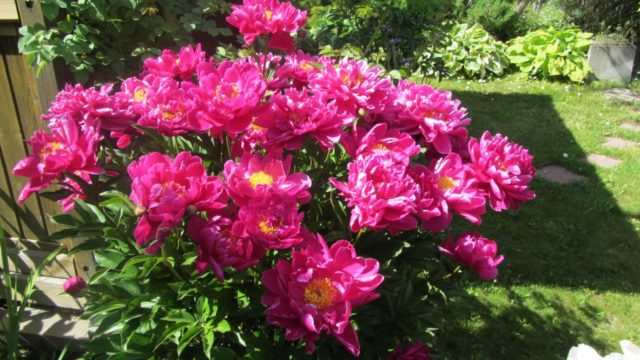
Flowers are large, double, serve as a real garden decoration
Flowering features
Peony Karl Rosenfeld belongs to herbaceous, medium late varieties. Flowering begins in early July and lasts about 2 weeks. Due to its beautiful flowers, the variety is often used for making bouquets. To extend the flowering time when cut, sugar and vinegar are added to the water. In this case, the water is changed daily.
- flowers are arranged singly, double or simple in shape;
- the structure is dense, large, 18 cm in size;
- the color of the flower is dark red with a purple tint;
- petals are large, ribbed, bent in waves;
- The aroma is sweet, attracting butterflies and pollinating insects.
Lush and long flowering depends on the place of growth, climatic conditions and adherence to agricultural practices. If all the care requirements are met, the bush will become a decoration of the summer cottage for a long time.
Application in design
Herbaceous peony Karl Rosenfeld is ideal for the embodiment of designer fantasies
But before decorating a flower garden, it is important to know what the peony is combined with.
Peony planting scheme Karl Rosenfeld:
- 3-4 plants are planted in the center of the flower garden, herbaceous or ground cover plants are placed around it.
- Peony is in perfect harmony with hybrid tea roses. While the rosebush is forming buds, Rosenfeld is already showing lush bloom. After it ends, the rose shows itself in all its glory, and the bright inflorescences look harmoniously against the background of the green foliage of the peony bush.
- Peony Karl Rosenfeld is suitable for creating mixborders. It is planted surrounded by garden geraniums, cuffs, ornamental onions and aquilegia.
- In order for the flower bed to delight the whole season with beautiful flowering, peonies are planted in combination with Siberian iris, large-rhizome geraniums, sedum, yarrow and common mordovia.
Flowers of the Buttercup family are not compatible with herbaceous peonies. Hellebore, anemone, lumbago quickly deplete the soil. Therefore, when growing together, peonies will not show a lush and beautiful flowering.
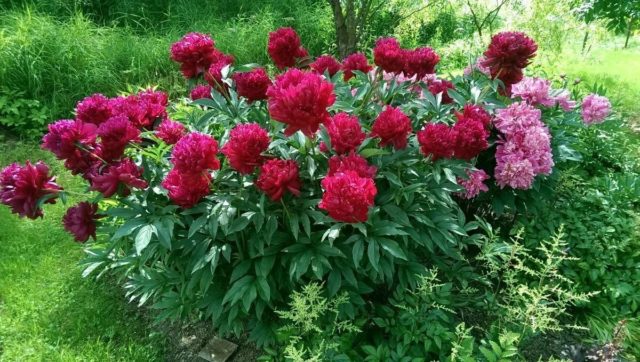
The variety goes well with herbaceous and flowering plants.
When creating a flower garden with a peony of the Karl Rosenfeld variety, it is important to remember that he:
attracts attention;
loves open sun and nutritious soil;
grows in one place for about 20 years;
because of the spreading, it requires a lot of space.
With the right combination of colors, the flower bed will become a decoration of the personal plot, it will bloom from early summer to late autumn.
Peonies after flowering
The end of the flowering period is not a reason to relax. Caring for the bushes should be continued, and the plant itself should be prepared for transplanting, pruning and wintering.
Transfer
It is better to replant in late August or early September. Before the onset of the first frost, the roots will have time to take root and survive the winter.
Pruning
Held a month before winter, this is around the middle or end of October. Shoots are cut so that hemp is no more than 20 cm above the soil.
Preparing for winter
The stumps of young plants are covered with immature compost or peat until spring. Mature bushes do not insulate for the winter.
For your information! In southern latitudes, it is not necessary to cover the plant due to the high frost resistance of the flower.
Peony Karl Rosenfeld - what is this variety, history of creation
Appeared in the south of China. They decorate the national emblem and use it as a design on fabrics. In Latin, peony is spelled paeonia, and Karl Rosenfield is pronounced by most people as "Rosenfield" rather than "Rosenfeld".

Peony Karl - garden decoration
Brief description, characteristic
The flower grows in a strong, spreading bush, up to 100 cm high. The shoots are thick, strong with openwork and smooth olive leaves. The bud is lush, bright pink, and a ruby hue appears by the fall season. Types of culture: herbaceous and lacto-flowered.
Note! Thanks to strong stems, the bush does not need to be tied up, but pruning is needed for decoration and full development.
Advantages and disadvantages of the variety
Like any plant, the Karl lactiflora Rosenfield peony has its pros and cons. Advantages:
- frost resistance;
- strong stems and root system;
- will grow in any soil;
- does not cause any particular difficulties when planting and leaving.
The disadvantage is that it does not grow in the Far North.
Choosing a landing site
There are no particular difficulties in growing. It grows well in any soil, although cultivated loamy soil is the best option. It is demanding on moisture, but it is inappropriate to place it in damp areas, where there may even be a short stagnation of water.From excessive moisture, rot appears on the roots, which contributes to the death of the culture. It should be planted away from trees so that the roots do not interfere with each other's development.
It should also be taken into account that "Karl Rosenfeld" is photophilous, therefore it is undesirable to plan its planting in shaded areas. In the shade, he will wither and will not be able to delight with his flowering.
It is advisable to choose an open sunny area where air will circulate well, but there will be no draft.
Peony Karl Rosenfeld: description of the herbaceous variety
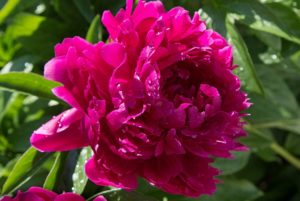
The peony cultivar Karl Rosenfield was developed in China. It is so beautiful that it is considered a national treasure of the country. Peonies also hold a special place in Japanese culture.
This variety was developed in the south of China. However, despite this, the species has excellent cold resistance. Therefore, the plant can be grown in more severe climates. The flower grows poorly only in the Far North.
The flower belongs to the milky-flowered group of herbaceous plants. During development, the bush forms fleshy and large root tubers. In an adult state, the height of the plant is 85–100 cm. Karl Rosenfeld gained immense popularity among flower growers thanks to the beautiful inflorescences that look amazing against the background of the green crown.
Due to its decorative appearance, this variety is often used to decorate front gardens, parks and squares. These flowers grow on any soil. The main thing is that the soil has the necessary level of nutrients. The variety is undemanding to care for and has high frost resistance.
It is worth noting that after planting or transplanting, varietal characteristics appear in a new place only at 2–3 years of age.
Appearance and flowering period
Outwardly, this flower is a herbaceous bush. The crown is formed quite spreading. Openwork leaves are formed on the shoots, the leaf blade of which is beautifully dissected. The leaves are light green at the beginning of the season. Their surface is shiny. The lush crown lasts until late autumn. At the same time, the color of the leaves changes from green to dark green with crimson shades.
The peony of the Karl Rosenfield variety is prized for its inflorescences. The buds of this flower have the following description:
- flowers are single. They are both semi-double and simple;
- inflorescences are dense and large. On average, their diameter is about 18 cm;
- the color of the petals is dark ruby or with purple hues. However, there are varieties with red, pink and white flowers;
- petals are large, with uneven edges. They are thin, which allows them to bend in a wave-like manner;
- the buds exude a sweet, unobtrusive and not sugary aroma.
Inflorescences are formed on strong and stable peduncles. Therefore, they do not need additional supports and do not break in strong gusts of wind. In height, peduncles can grow up to 85-100 cm.
This is a medium late variety. It begins to bloom in early July. Long flowering. The inflorescences are able to remain fresh and beautiful for a rather long period in the cut state. To extend this time, sugar or vinegar should be added to the cut flower stalks. Moreover, the water itself must be changed every day.
This variety of peony is grown both as single bushes and in whole groups. This variety is suitable for landscape design when creating mixed plantings. Inflorescences are often used to organize bouquet arrangements.
Nuances of content
To grow such a peony in your country house, you need to know the following nuances of its content:
- the growing area should be sunny and moderately warm. Drafts must not be allowed;
- when planting seedlings, you need to ensure that the recovery bud is at a level of 3-5 cm from the existing soil level. If you deviate, flowering will not occur;
- the optimal soil for planting is fresh and moderately dry, rich in micro- and macro-nutrients;
- watering is performed regularly as the top layer of the soil dries out;
- dressing is applied in early spring, before the start of the growing season. During the period of active growth and budding, mineral fertilizers should be used. In the second half of the season, organic matter must be used to feed the bushes;
- the most dangerous parasites for the peony of this variety will be ants. They slow down flowering and are capable of infecting the plant with pathogenic microflora. Therefore, periodically planting must be sprayed with protective solutions;
- Wintering in the middle lane is carried out without wrapping and additional shelters.
As you can see, the Karl Rosenfield peony is an unpretentious cultivar in terms of cultivation, which will become a worthy decoration for any garden.
Do you have questions and need answers? Ask a question to a specialist
Preparation of planting material
Both seeds and cuttings can be used as planting material. But there are unreasonably many worries with seeds, and such a plant will bloom only in five years. Therefore, the best option is to land the divisions. An adult bush, whose age varies from 8 to 10 years, must be divided into parts along with the roots. Each such part is a ready-made division. You need to make sure that there are no more than 3-5 kidneys on it. Since the roots are damaged by division, they will not be able to supply more buds with food, and as a result, the bush will develop poorly, hurt and look ugly.
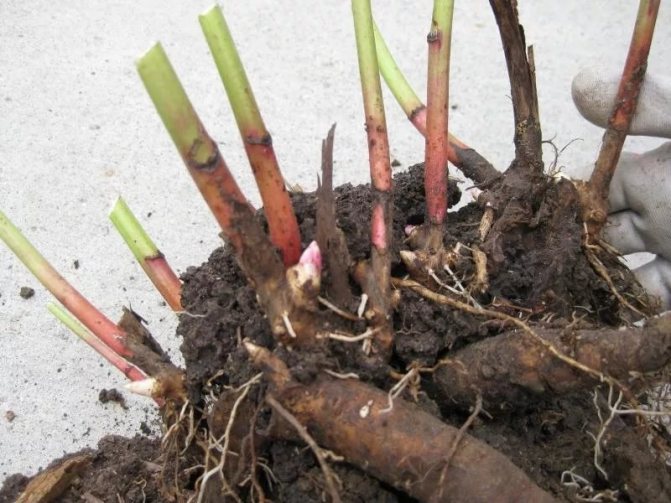
The length of the roots should be about 15–17 cm, the excess should be cut off. To treat the cuts, a mixture of wood ash and any fungicide should be made. After application, it will protect the roots from various unpleasant diseases, as well as prevent rotting. The cuttings prepared in this way can be planted in open ground.
Landing rules
Planting time is April and September.
The planting pit should be 50 centimeters long and 50 centimeters wide. Compost and humus are placed on its bottom layer, 1-2 glasses of double superphosphate and the same amount of wood ash are added. The resulting mixture is mixed
You can simply fill the middle layer with garden soil and start planting.
The plant is placed in the center of the pit, so that the buds are at the top, and the spare roots are horizontally or slightly obliquely
It is very important that the depth of the buds is no more than 5 centimeters, otherwise the bush will not be able to bloom for a long time.
The top layer is very carefully and neatly filled with earth and compacted with your hands, you cannot trample it down with your feet. A roller is formed around the hole from the soil, and watering is performed
If the soil subsides, it is advisable to add a little more earth from above.
If you plan to plant a group of peonies, the optimal distance between the grooves should be about 1 meter, so as not to interfere with their successful rooting and growth.
Description of the variety
We recommend that you familiarize yourself
Peony Karl Rosenfeld belongs to the milky-flowered species and has large fleshy root tubers. The height of an adult plant varies from 85 to 100 cm, but the main notable feature of a peony is its flowers. Karl Rosenfeld has them amazing. Terry, very large and bright, these flowers will not go unnoticed in any garden area. Their shade is varied - from ruby to red-violet.
The petals of this peony are beautiful individually as well. Each of them is rather large, wave-like curved, but thin. Another advantage of the flower is its aroma - sweet, but not cloying and unobtrusive.
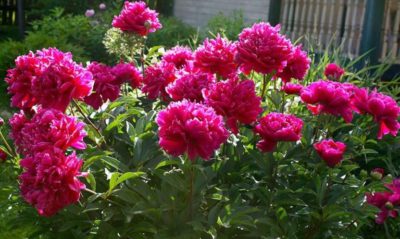
This peony will decorate any area. It can be used to design individual flower beds or create large compositions with the participation of other plants. It will be in place everywhere, because thanks to its rich color and large size, the plant looks like a king.
Specificity of care
The perennial will not bloom in the first year, since all forces are directed to the growth of the leaf mass. Watering is not necessary often, but at the same time it is very abundant, about 2 buckets of water. A young shoot should not be allowed to bloom, so the buds that appear on it are cut off. This is necessary so that in a year he gains the necessary strength to form a healthy, strong and abundantly flowering bush in the future.
Within two years after planting, additional fertilizing is not needed, those that were introduced initially are enough. After flowering (this usually happens after 2-3 years), it is advisable to use special fertilizers. The soil must be loosened as a preventive measure against overgrowth of weeds. At the onset of late autumn, the stems are recommended to be cut flush with the ground. She does not need shelter for the winter.
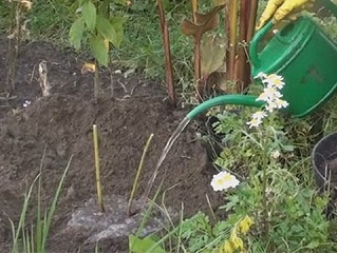
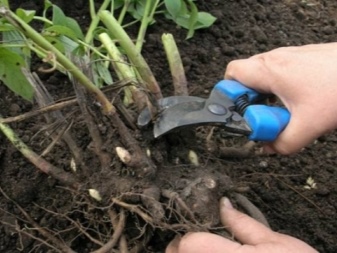
Appearance and flowering period
Outwardly, this flower is a herbaceous bush. The crown is formed quite spreading. Openwork leaves are formed on the shoots, the leaf blade of which is beautifully dissected. The leaves are light green at the beginning of the season. Their surface is shiny. The lush crown lasts until late autumn. At the same time, the color of the leaves changes from green to dark green with crimson shades.
The peony of the Karl Rosenfield variety is prized for its inflorescences. The buds of this flower have the following description:
- flowers are single. They are both semi-double and simple;
- inflorescences are dense and large. On average, their diameter is about 18 cm;
- the color of the petals is dark ruby or with purple hues. However, there are varieties with red, pink and white flowers;
- petals are large, with uneven edges. They are thin, which allows them to bend in a wave-like manner;
- the buds exude a sweet, unobtrusive and not sugary aroma.
Inflorescences are formed on strong and stable peduncles. Therefore, they do not need additional supports and do not break in strong gusts of wind. In height, peduncles can grow up to 85-100 cm.
After flowering is complete, the buds, like most of the shoots, are cut off, and the plant prepares for winter. Due to its high cold resistance, this peony in the southern regions can not be sheltered for the winter, in contrast to areas with a more severe climate.
This variety of peony is grown both as single bushes and in whole groups. This variety is suitable for landscape design when creating mixed plantings. Inflorescences are often used to organize bouquet arrangements.
Appearance and flowering period
Outwardly, this flower is a herbaceous bush. The crown is formed quite spreading. Openwork leaves are formed on the shoots, the leaf blade of which is beautifully dissected. The leaves are light green at the beginning of the season. Their surface is shiny. The lush crown lasts until late autumn. At the same time, the color of the leaves changes from green to dark green with crimson shades.
The peony of the Karl Rosenfield variety is prized for its inflorescences. The buds of this flower have the following description:
- flowers are single. They are both semi-double and simple;
- inflorescences are dense and large. On average, their diameter is about 18 cm;
- the color of the petals is dark ruby or with purple hues. However, there are varieties with red, pink and white flowers;
- petals are large, with uneven edges. They are thin, which allows them to bend in a wave-like manner;
- the buds exude a sweet, unobtrusive and not sugary aroma.
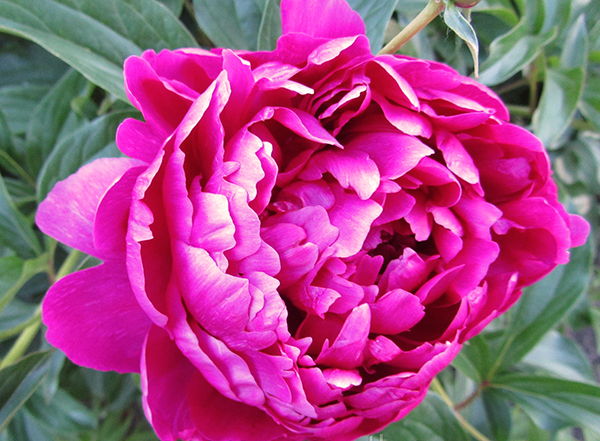
Inflorescences are formed on strong and stable peduncles. Therefore, they do not need additional supports and do not break in strong gusts of wind. In height, peduncles can grow up to 85-100 cm.
This is a medium late variety. It begins to bloom in early July. Long flowering. The inflorescences are able to remain fresh and beautiful for a rather long period in the cut state. To extend this time, sugar or vinegar should be added to the cut flower stalks.Moreover, the water itself must be changed every day.

After flowering is complete, the buds, like most of the shoots, are cut off, and the plant prepares for winter. Due to its high cold resistance, this peony in the southern regions can not be sheltered for the winter, in contrast to areas with a more severe climate.
This variety of peony is grown both as single bushes and in whole groups. This variety is suitable for landscape design when creating mixed plantings. Inflorescences are often used to organize bouquet arrangements.



